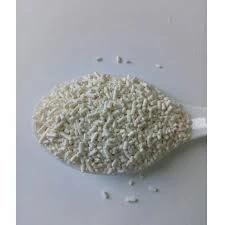
Understanding the Role of Maltodextrin as a Food Preservative and Its Benefits
The Role of Maltodextrin as a Preservative
Maltodextrin, a polysaccharide derived from starch, is widely used in the food industry for a variety of purposes, including as a thickening agent, stabilizer, and, notably, as a preservative. Its unique properties make it a versatile ingredient in many food products, enhancing texture, flavor, and shelf life.
What is Maltodextrin?
Maltodextrin is produced by hydrolyzing starch, typically from corn, rice, or potatoes. The process involves cooking the starch and then enzymatically breaking it down into short chains of glucose molecules. This results in a white, powdery substance that is water-soluble, with a mildly sweet taste. Maltodextrin is classified as a complex carbohydrate and is commonly used as a food additive, particularly in processed foods.
The Preservative Properties of Maltodextrin
One of the primary reasons maltodextrin is utilized as a preservative is its ability to absorb moisture. By decreasing the water activity in food products, maltodextrin helps inhibit the growth of spoilage bacteria, yeast, and mold. This moisture-absorbing ability extends the shelf life of food items by creating an environment that is less conducive to microbial growth.
Moreover, maltodextrin can act as a bulking agent in low-sugar or low-fat food formulations, where it can help maintain texture and mouthfeel while simultaneously enhancing stability. This is particularly beneficial in products like snack foods, sauces, and dressings, where a desirable consistency is essential for consumer appeal.
Applications in Food Products
maltodextrin preservative

Maltodextrin is prevalent in numerous food products across various categories. In the realm of snacks, it's commonly found in chips and extruded snacks, where it contributes to an appealing crunch while aiding in preservation. It is also used in powdered drink mixes and instant foods, where it helps to improve solubility and shelf stability.
In the dairy sector, maltodextrin plays a key role in powdered milk and creamers, enhancing texture while preventing clumping. Furthermore, it is often used in sauces and dressings to ensure a smooth, homogenous consistency, preventing separation during storage.
Health Considerations
While maltodextrin is generally recognized as safe (GRAS) by the U.S. Food and Drug Administration (FDA), some health considerations warrant attention, particularly for individuals who are sensitive to sugar or who have specific dietary restrictions. Maltodextrin has a high glycemic index, meaning it can cause a rapid spike in blood sugar levels. Therefore, individuals with diabetes or those on carbohydrate-restricted diets should be cautious about their intake.
Additionally, as maltodextrin is derived from starch, which is often genetically modified, consumers interested in avoiding GMOs should look for certified organic products or those labeled as non-GMO.
Conclusion
Maltodextrin stands out as a valuable ingredient in the food industry, not only enhancing flavor and texture but also serving as a functional preservative. Its ability to absorb moisture proves advantageous in extending the shelf life of a wide range of products. However, like any food additive, it should be consumed in moderation, with consideration given to its effects on blood sugar levels and dietary restrictions.
As consumer awareness of food ingredients continues to grow, manufacturers are challenged to provide transparent labeling and clearer information on the use of additives like maltodextrin. In this evolving landscape, the balance between food safety, quality, and health will shape the future of food formulations—ensuring that beneficial ingredients such as maltodextrin can be enjoyed without compromising consumer health.
-
Pure Sodium Dichloroisocyanurate Dihydrate | Powerful DisinfectantNewsAug.29,2025
-
Industrial Chemicals: Quality & Purity for Every IndustryNewsAug.28,2025
-
Nitrile Rubber Honoring Strict Production StandardsNewsAug.22,2025
-
Aspartame Ingredients Honoring Food Safety ValuesNewsAug.22,2025
-
Fertilizer for Balanced Plant NutritionNewsAug.22,2025
-
Cyanide Gold Processing with High Purity AdditivesNewsAug.22,2025
-
Formic Acid in Textile Dyeing ApplicationsNewsAug.22,2025
Hebei Tenger Chemical Technology Co., Ltd. focuses on the chemical industry and is committed to the export service of chemical raw materials.
-

view more DiethanolisopropanolamineIn the ever-growing field of chemical solutions, diethanolisopropanolamine (DEIPA) stands out as a versatile and important compound. Due to its unique chemical structure and properties, DEIPA is of interest to various industries including construction, personal care, and agriculture. -

view more TriisopropanolamineTriisopropanolamine (TIPA) alkanol amine substance, is a kind of alcohol amine compound with amino and alcohol hydroxyl, and because of its molecules contains both amino and hydroxyl. -

view more Tetramethyl Thiuram DisulfideTetramethyl thiuram disulfide, also known as TMTD, is a white to light-yellow powder with a distinct sulfur-like odor. It is soluble in organic solvents such as benzene, acetone, and ethyl acetate, making it highly versatile for use in different formulations. TMTD is known for its excellent vulcanization acceleration properties, which makes it a key ingredient in the production of rubber products. Additionally, it acts as an effective fungicide and bactericide, making it valuable in agricultural applications. Its high purity and stability ensure consistent performance, making it a preferred choice for manufacturers across various industries.





